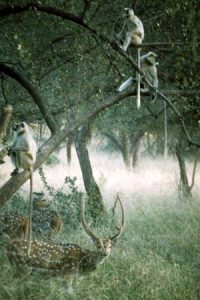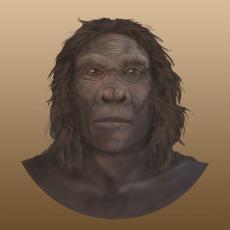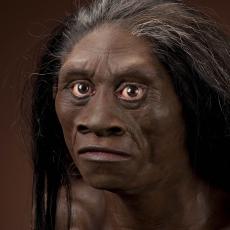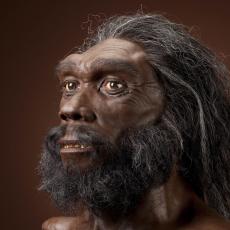
Primate evolution: The earliest primates probably looked something like this little marmoset monkey.
When did the first primates evolve?
The first primates evolved out of earlier mammals around 56 million years ago, in the Tertiary period. (Or possibly as early as 85 million years ago, even before the dinosaurs died.)
Why did primates evolve when they did?
Earlier gymnosperms – evergreens with pine cones – had just evolved into fruit trees – angiosperms – and forests covered the Earth. Primates evolved out of small crawling and climbing animals that looked like rats or squirrels or weasels. Primates evolved to live in these forests – mostly hot, wet forests near the Equator, in Africa and South America and Southeast Asia. At first, primates climbed trees to eat insects. Most primates still eat insects today. But primates also evolved to eat the fruit and nuts they found in the trees, and even the young leaves.
How were primates different from earlier animals?
Because primates evolved to live in the trees, they had hands and feet that could grab on to branches. Their tails helped them balance, and their shoulders rotated all the way around, so they could swing from tree to tree. Primates used their eyes more than their noses, compared to other mammals, and they had bigger brains. Gradually some primates evolved bigger bodies, too. Some of them developed opposable thumbs, like your thumbs. Like the earlier small mammals, primates are very diverse. There are a lot of different kinds of primates!

Monkeys and deer
How long did primates live?
Primates took a longer time to grow up than earlier mammals, but they also lived longer lives. Mice have babies when they are only about two months old, and they die when they are about two years old. Primates evolved to have babies when they were about two and a half years old. They lived to be as old as forty. That meant that primates couldn’t evolve as quickly as mice, but they had more chances to learn things from their parents.
What did primates eat?
Primates ate mostly fruit (especially figs) and nuts, which they could pick in the trees. Many primates also ate leaves from the trees. Many primates, like chimpanzees, still live this way.
Did primates like alcohol?
Like other mammals, primates evolved to like the effect of alcohol on their bodies. That’s because following the smell of rotting fruit – the smell of alcoholic fruit – is an excellent way to find fruit trees in a forest with lots of different kinds of trees in it. Primates that were good at finding fruit trees lived more successfully and had more babies. But they also ate fermented fruit and got tipsy on it, like other mammals.
When did gorillas split off from other primates?
About nine million years ago, the primate ancestors of gorillas parted ways with the ancestors of humans. Gorillas became very big and strong. They spent more time on the ground, and lost their tails. If you’re walking upright a lot of the time, your tail just gets in your way and trips you up. The more time gorillas spent on the ground, walking or standing, the shorter and stubbier their tails got, until finally they didn’t have tails at all.
When did the first hominids evolve from earlier primates?
The first hominids – primates that were more like modern people – evolved in Africa about six million years ago, when they split off from the ancestors of chimpanzees. The hominids were primates that evolved to be able to stand on two feet. Standing up may have let them use both hands to catch fish and crabs. They could dig up clams and mussels in the shallow water. Seafood is very good for you! Probably these early hominids – we call them australopithecines – also ate water plants, like seaweed. With all that extra food, hominids grew bigger and stronger and smarter. That would be a great paleo diet – mostly seafood and fruit and nuts, nori and leafy greens (and maybe some wine!).
When did hominids start to run and lose their body hair?

Early humans: homo habilis was the first to be hairless, with black skin, and to be able to run and sweat. (Reconstruction from the Smithsonian Institution)
About three million years ago, the first people started to run. They evolved big toes, so they could really push off and go fast. Probably these runners chased gazelles and antelope across open grassland. These hunters evolved to lose their body hair. They evolved to be able to sweat, in order to cool their bodies and keep hunting longer. To protect themselves from sunburns, they evolved to have black skin. All early humans had black skin.
These first people – homo habilis, we call them – also started to make stone tools to cut and scrape things. Maybe they also made tools out of animal bones.
Were there different species of early hominids?

Early humans: homo floresiensis was small. They may have been the first to leave Africa. (Reconstruction from the Smithsonian Institution)
People didn’t all evolve the same way. As with monkeys today, long ago there were many different species of people. They were all hairless, with dark skin, and all of them could sweat and run. All of them ate fish.
But they were different in other ways. A little less than two million years ago, Homo gautengensis lived in South Africa and was small, only about three feet tall. They seem to have mostly eaten plants. About the same time, Homo erectus lived in East Africa, and was tall, with long arms and legs like modern humans. They stood upright – that’s why we call them erectus. There were probably other species, too, that we don’t know about yet.
When did hominids first leave Africa?

Early humans: homo heidelbergensis was the first human species to settle in cold northern places.
About two million years ago, some of the Homo erectus left Africa. The earliest ones to leave Africa may have been a group known as Homo floresiensus. They got all the way to Indonesia, maybe following the coastline. Once they were in Indonesia, they seem to have evolved to be shorter. Like the earlier homo gautengensis, Homo florensiensus was also only about three feet tall, but they were still hunters.
Other groups of homo erectus left Africa a little later, about 1,700,000 BC. Homo erectus settled all across Asia, all the way to China.
Meanwhile, most of the homo erectus had stayed in Africa. About 800,000 BC, they evolved into homo rhodensiensis. Once again, some of these chose to leave Africa. That was around 600,000 BC. We call these travelers homo heidelbergensus. These people went north instead of east. They were the first hominids to live in cold climates. They had beards and bigger noses so they could breathe better in the cold air. And they had short arms and feet, and short wide bodies, so they wouldn’t lose too much heat.
Once they were in Asia and Europe, about 400,000 BC, the homo heidelbergensus people split a second time. Some of them became the Neanderthals, while others became the Denisovans. Neanderthals lived all over Europe and West Asia and Denisovans lived in Central Asia. When they met, they still often had babies together.
When did modern humans evolve from those hominids?
Meanwhile, about 300,000 BC, the homo rhodensiensis that had stayed in Africa evolved into homo sapiens.Then about 200,000 BC, they evolved into homo sapiens sapiens. Homo sapiens sapiens first left Africa about 140,000 BC. When they arrived in Europe and Asia, they had babies with the Neanderthals and Denisovans they met there. So today, modern humans have genes from all of these earlier hominid groups – probably they had babies together pretty often, so we are made of mixes of the most successful features of all of these early types of people.
Are humans really part Neanderthal?
Of course most of our genes are all the same. But we get genes for bigger jaws that can fit wisdom teeth comfortably from Neanderthals, and genes for straight hair, big noses, white skin and red hair. From the Denisovans, we get genes for breathing in high altitudes, and immunity to some diseases. Other than that, for situations where Neanderthals, Denisovans and homo sapiens had different genes, most of the genes in modern people come from homo sapiens.
But most of the species of primates are still small and covered with fur. They still live in trees and eat insects and fruit, just like they always have. Today there are more than 200 different species of primates all over the world.
More about chimpanzees
More about early humans
Bibliography and further reading about primates: